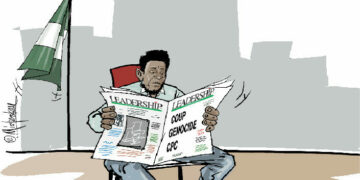Did you read my piece titled “The Silent Safety Guardian,” published on July 12, 2025? In that piece, I lamented my visit to Apo Mechanic Village in Abuja, the Federal Capital Territory, to procure four tyres for my car at a cost I found astounding. What I didn’t share with you was that the visit to Apo was the outcome of an earlier visit to my vulcanizer, whose verdict was that my four tyres needed to be changed.
Initially, I ignored his counsel, like most car owners, because of the scary price of tyres. This changed when the news of the death of Diogo Jota, the Liverpool player, in a car crash hit the internet. I don’t know when you last visited your roadside vulcanizer or the professionals whose business it is to service and also check alignment and wheel balancing. When you do, you will be stunned when the verdict is that one or two of your tyres are either incorrectly inflated, worn out, or both.
Last week, I told you that tyre bursts are dangerous killers. I wrote that excessive speed increases the risk of a tyre burst due to the added stress and heat generated, potentially leading to a blowout.
Meanwhile, tyre failure due to excessive speed is commonplace. Both excessive speed and tyre bursts are dangerous, especially if the tyres that influence a vehicle’s handling, braking, acceleration, and overall stability are substandard. Fatigue completes the risky circle.
I have chosen to treat this dangerous trio, starting with tyre blowouts. Incorrect tyre pressures are the cause of tyre blowouts.
I don’t know if you still recall what Spain’s Guardia Civil said in their statement on the Diogo crash. They said that their investigation “points to a road accident due to a burst tyre while overtaking”.
Another source claimed that before setting out, he allegedly noticed that the tyres and brakes seemed faulty, which he wanted to check, but Andre convinced him otherwise. The suspected faulty tyre, induced by speed, blew during high-speed overtaking, causing the car to lose control, thereby crashing and catching fire.
Meanwhile, another source said the police were investigating the crash as “a possible speeding incident”. Again, let me repeat that incorrect tyre pressure is the number one cause of tyre blowouts, sudden tyre failures, and premature tyre wear.
Incorrect tyre pressure is an invitation to disaster, even if the tyres are brand new. It is a time bomb waiting for the right time to explode. The implication is that each time such a vehicle is driven, the occupants are facing grave dangers without being aware.
So, what are the types of incorrect tyre inflation? There are two types of incorrect tyre pressure: over-inflation and under-inflation.
Let’s take a look at how they can affect your tyres and cause disaster, and what could be done to maintain proper pressure for your tyres and so prevent or drastically minimize blowouts and other forms of tyre failures.
Under-inflation is the major cause of tyre blowouts. Not witches. Not the spirit realm. When a tyre is under-inflated, it increases what is known as the Rolling Resistance (RR) but generates a tremendous amount of heat that could make your tyre explode like a bomb.
Such an explosion (blowout) would destabilize the vehicle’s balance, leading to a crash and disaster. For other types of tyre failures, over-inflation is the cause. When over-inflated, a tyre becomes stiff. This can make it puncture easily. The internal materials used in making the tyre are also subjected to undue strain.
This would make them snap, leading to bulges or swells. As the tyres hit a pothole or a bump, they can easily cut and have a sudden deflation that could cause a crash. Over-inflation also leads to partial contact of the tyres with the road surface.
This reduces traction and can easily lead to loss of control when one is on a high-speed, wet surface, cornering, or braking. Each of these conditions can easily lead to a crash and disaster.
The relief is that these can be prevented. There are two very effective options for prevention, or drastic reduction, of blowouts and other forms of tyre failures. The first option is to own a quality tyre pressure gauge.
As pointed out earlier, incorrect tyre pressure is the major cause of blowouts and sudden tyre failures. So, correct tyre pressure is a must for any safety-conscious motorist. But the big question is, how do you ensure that what the vulcanizer pumped into your tyres is the correct pressure?
Only a quality tyre pressure gauge will tell you that. A quality gauge will also enable you to gauge your tyres at the right time and to ensure that all the tyres maintain correct pressure before the vehicle is driven out for the day.
This is particularly important if you are in the transport business, travelling, or you work in a sector where your vehicle is a vital daily tool. Never rely on the roadside vulcanizer’s gauge. Most of their gauges are outrightly inferior, have been overused/abused over time, and may have improper measuring units. In fairness to the vulcanizers, however, they may not be aware of these shortcomings with their gauges.
The second option is to install a high-profile automatic tire monitor. This is a state-of-the-art device that uses sensors and wireless monitors to monitor your tires on a 24-hour basis.
It alerts the driver well in advance about an impending tire blowout or failure. It pinpoints the exact tire so that the driver will take appropriate measures to deal with the situation. It also effectively takes care of premature tire wear.
So, what is your vehicle’s correct tire pressure? By the end of the driver’s door of your vehicle, or in the vehicle’s manual, you will see specifications that show the sizes of tires for your vehicle and the inflation pressure for the tires in psi (pounds per square inch).
Religiously stick to that specification. Do not allow anyone, especially vulcanizers, to tell you otherwise unless you want to gamble with your life. It is instructive to note here that it is not the tyre manufacturer that determines the pressure for your tyres but the vehicle manufacturer. It is the vehicle manufacturer that specifies the size of tyres and the pressure to be given to the tyres.
He has taken into consideration the weight, speed, number of passengers, artificial inflation by heat, and other factors to determine what the proper inflation pressure should be.
The specifications you see on the tyres are to enable you to match the specifications of the vehicle manufacturer. In this light, it is equally dangerous to use tyre sizes different from what the vehicle manufacturer specified for the vehicle.
Let’s conclude with gauging/pumping your tyres at the right time. The right time is when the tyre is cold. Mornings are the ideal time.
So, before you drive off, gauge your tyres and, if there is a need to pump, slowly drive to the nearest vulcanizer. If you are the type who leaves home early, weekends may be the most convenient time. When hot, the tyre pressure increases.
Any action (gauge, pump) you take when the tyres are hot would be misleading and could be fatal. Unfortunately, most people gauge and pump tyres when the tyres are hot. Never do so. If the tyres are hot, leave them for about 30 minutes to cool down.





